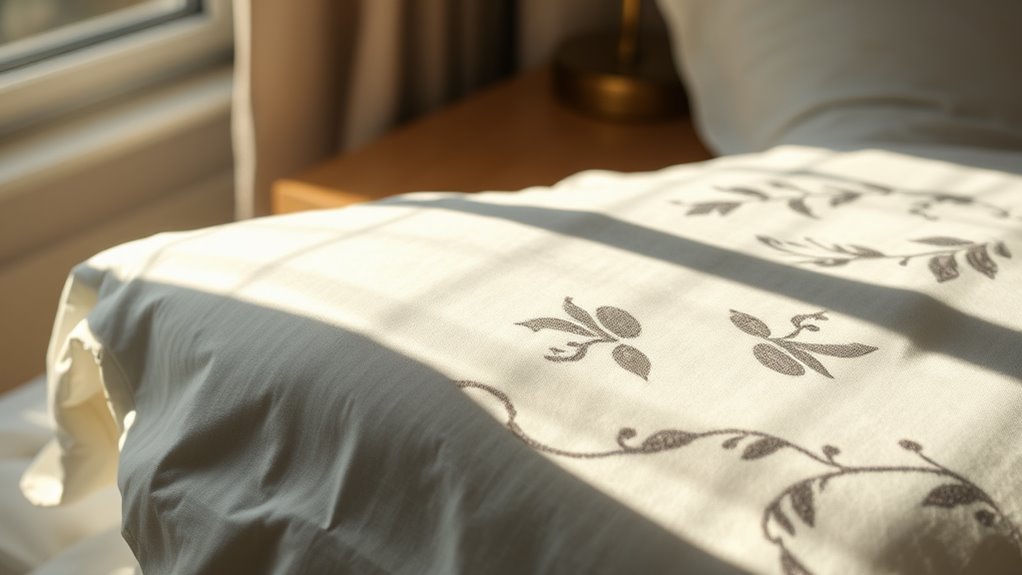Could Your Pillowcase Be Contributing to Your Breakouts.
Your pillowcase could definitely be contributing to your breakouts. It traps oils, dirt, and bacteria from your skin, which can clog pores and lead to acne. Not changing your pillowcase regularly allows these impurities to transfer back to your skin, causing irritation. Experts recommend washing it at least once a week, or even more often if you have oily skin. Curious to learn more about how to maintain your pillowcase for better skin health?
The Connection Between Pillowcases and Skin Health
Your pillowcase plays a surprising role in your skin health. You mightn’t realize it, but the fabric resting against your face every night can impact your chances of experiencing acne. When you sleep, oils, dirt, and bacteria accumulate on your pillowcase. If you don’t change it regularly, these impurities transfer back to your skin, potentially clogging your pores and triggering breakouts.
Selecting the right pillowcase is essential if you want to maintain clear skin. Silk and satin pillowcases are often recommended since they’re gentler on your skin and can help reduce friction. Additionally, dirty pillowcases can harbor bacteria, which may exacerbate skin issues.
Washing your pillowcase weekly ensures you’re giving your skin a clean, fresh environment. It’s a simple step that can lead to significant improvements in your complexion.
Join others who care about their skin health and make this small change—it could help you feel more confident in your own skin.
Common Skin Issues Linked to Dirty Pillowcases
While it may seem insignificant, sleeping on a dirty pillowcase can lead to various skin issues, such as acne, irritation, and uneven texture.
Think about it: your face spends hours pressed against that fabric, absorbing oils, sweat, and product residue. When you don’t wash your pillowcase regularly, these accumulations can clog your pores, causing breakouts that make you feel less confident.
You might also experience irritation or redness, especially if you have sensitive skin. This irritation can come from allergens like dust mites or leftover skincare products that find their way onto your pillowcase.
Plus, an uneven texture can leave your skin looking dull and tired, making it harder to feel your best. Regularly changing your pillowcase can help minimize these issues and promote clearer skin.
How Bacteria Accumulates on Your Pillowcase
Bacteria can quickly accumulate on your pillowcase, especially since it often comes into contact with sweat, skin cells, and saliva. Every night, as you lay your head down, you’re introducing a mix of these elements onto your pillow.
If you sleep on the same pillowcase for weeks without washing it, bacteria thrive in that environment. They multiply, creating a breeding ground for germs.
When you turn your head or toss and turn, those bacteria transfer back onto your skin. You mightn’t realize it, but this can lead to breakouts and skin irritations, impacting your confidence.
Often, we share pillowcases with family or friends, which only increases the chance of bacteria hitching a ride. Washing your pillowcase regularly encourages a healthier sleeping environment, helping you feel your best. Additionally, skipping your skincare routine can exacerbate the effects of bacteria on your skin, leading to increased breakouts.
You deserve a clean space for restful nights and glowing skin—so don’t overlook that pillowcase’s importance!
The Role of Oil and Dead Skin Cells in Breakouts
As you sleep, oil from your skin and dead skin cells can accumulate on your pillowcase, creating an environment ripe for breakouts. This buildup can block your pores, trapping dirt and bacteria, leading to inflammation and those unwanted blemishes.
You mightn’t realize it, but your pillowcase plays a crucial role in your skin’s health. When you toss and turn through the night, you’re pressing your face into all those particles, which isn’t exactly a recipe for a clear complexion.
Imagine waking up refreshed, your skin smooth and radiant instead of irritated. You want to feel confident and connected with others, right?
By being mindful of what touches your face while you sleep, you’re taking a simple yet powerful step toward healthier skin. Dehydrated skin can often trigger excess oil production, leading to more breakouts as you sleep. Let’s embrace this small change together and make sure our pillowcases aren’t sabotaging our skincare efforts.
You deserve to wake up looking and feeling your best!
Recommended Washing Frequency for Pillowcases
To keep your skin clear and healthy, how often you wash your pillowcases is key. Experts recommend washing them at least once a week. This regular cleaning helps remove oils, dirt, and bacteria that accumulate while you sleep.
If you’re prone to breakouts or have oily skin, consider washing your pillowcase every three to four days. You’ll create a much cleaner sleep environment, making your skin feel refreshed and revitalized.
Additionally, regular cleaning of your pillowcase can significantly reduce the presence of acne-causing bacteria that may lead to breakouts.
By establishing this routine, you’re taking an easy but impactful step towards clearer skin.
Let’s be honest: we all want to feel good in our own skin and be part of that supportive community striving for better skin health.
Choosing the Right Fabric for Your Pillowcase
When it comes to maintaining healthy skin, the fabric of your pillowcase plays a crucial role. Choosing the right material can help prevent breakouts and improve your overall skin health.
Here are some fabrics to consider for your pillowcase:
-
Cotton: Breathable and hypoallergenic, it absorbs moisture and keeps skin dry.
-
Silk: Gentle on the skin and hair; reduces friction and helps retain moisture.
-
Bamboo: Naturally antibacterial, it’s soft, breathable, and great for sensitive skin.
-
Linen: Highly breathable, it helps wick away sweat and is durable for long-term use.
-
Microfiber: Soft and silky, it resists dust mites and allergens, perfect for acne-prone skin.
Finding the right fabric for your pillowcase can make a world of difference. In addition to fabric choice, using evidence-based ingredients in your skincare routine can further calm irritation and reduce redness.
Embrace your skin’s needs, and choose wisely to create a cozy environment that supports your skin’s health. You deserve that!
Additional Tips for Maintaining Clean Bedding
Maintaining clean bedding is essential for healthy skin, and there are several straightforward practices you can adopt.
First, change your sheets and pillowcases at least once a week to remove sweat, oils, and dirt. Don’t forget to wash your duvet cover and blankets regularly, too. Use a gentle, hypoallergenic detergent to avoid skin irritation.
Consider using a mattress protector; it can keep dust mites and allergens at bay. And when you’re washing your bedding, opt for hot water—this helps eliminate bacteria.
Remember to regularly fluff and air out your pillows and comforters to keep them fresh. If you have sensitive skin, choose fragrance-free cleaning products that won’t aggravate your complexion.
Lastly, take a moment to establish a bedtime routine that includes changing into clean sleepwear. These small actions can make a big difference in how your skin looks and feels.
The Impact of Sleep Position on Skin Clarity
While keeping your bedding clean plays a significant role in promoting healthy skin, your sleep position also affects skin clarity. You mightn’t realize it, but the way you sleep can contribute to breakouts.
-
Sleeping on your stomach can cause your face to press against the pillow, trapping oils and bacteria.
-
Side sleeping may lead to friction, which irritates the skin and can lead to inflammation.
-
If you’re prone to acne, consider sleeping on your back to minimize contact with your pillowcase.
-
Make sure your hair isn’t touching your face while you sleep to avoid transferring oils.
-
Elevating your head can help reduce swelling and improve circulation, benefiting your skin overnight.
Taking note of your sleep position can be a simple yet effective way to support your skin. By making small adjustments, you can wake up with a clear, radiant complexion that fosters confidence!
When to Replace Your Pillowcase for Optimal Skin Care
Since your pillowcase can accumulate oils, dirt, and bacteria over time, knowing when to replace it’s crucial for maintaining healthy skin.
Ideally, you should swap out your pillowcase every three to four days, especially if you have oily or acne-prone skin. This regular change helps minimize the buildup of irritants that could lead to breakouts.
If you’ve been sweating more than usual or notice a lingering smell, it’s definitely time to make the switch.
Also, consider replacing your pillowcase after you’ve been sick or if your skin flares up unexpectedly—this helps prevent bacteria from lingering.
Join a community that values skin health and self-care, and let your friends in on this tip—after all, sharing knowledge enhances your connection.

